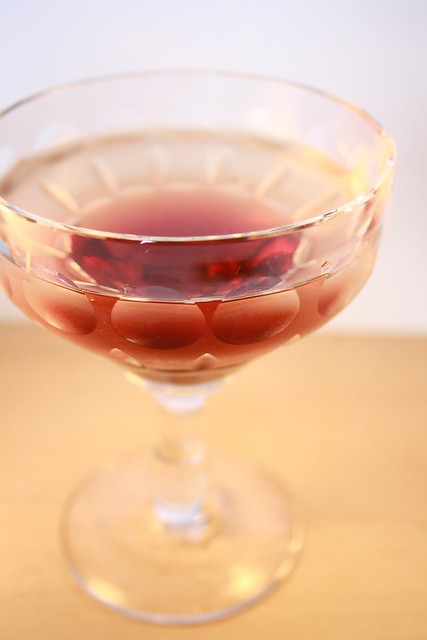Thirty Six: Saint's Quarter
In which the Company decides that frankly, it's our ball and if we want to go home, all of you can't play anymore, so be nice.
Read MoreIn which the Company decides that frankly, it's our ball and if we want to go home, all of you can't play anymore, so be nice.
Read MoreOne last blast on the cachaca front - it turns out that I've only got two weeks to put together a recipe for the 2010 Cocktail World Cup, so the next batch of drinks are going to be more focused on a certain Antipodean vodka. Anyhow, aged cachaca worked pretty well in a twist on the traditional Old-Fashioned. How does it fare in a modified Manhattan?
Good, as it happens. Abelha Gold is aged for three years but it won't stand up to a particularly robust style of sweet vermouth, so it's probably worth leaving the Punt E Mes and the Dubonnet in the fridge.

Downtown Rio
50ml Abelha Gold cachaça
20ml Martini Rosso
1 barspoon maraschino liqueur
2 dashes Angostura Orange bitters
Stir all ingredients with ice and fine-strain into a chilled martini glass. Garnish with an orange zest twist.
I've been using a bottle of Punt E Mes as my go-to sweet vermouth for a good while now. I'm a big fan of the bitter note it brings to drinks, but I've been predominantly using it as a generic sweet vermouth which has slightly warped my expectations of certain drinks at the bitter end of the scale. Case in point: the Negroni. When I have one in a bar, I can notice the absence of the extra bitterness provided by the Punt E Mes and it takes me an instant to remember that it's my Negronis that are slightly out of whack, not the one I've just bought.
But then it also occurs to me that bitter is a very divisive flavor, and that if I can up the bitter content of a Negroni, surely it's possible to mellow it out a little.

Twice-Shy Negroni
45ml Plymouth Gin
30ml Martini Rosato
4 mint leaves
50ml Campari (in an atomizer)
Give the mint leaves a quick smack to wake them up and place them in the base of a mixing glass. Add the gin and vermouth and stir with ice. Strain into an ice-filled old-fashioned glass. Spray some Campari over the top and garnish with an orange zest and a mint sprig.
If David Embury is to be believed, mixed drinks fall roughly into two categories - cocktails of the sour type, and those of the aromatic type. The former covers drinks that include - surprise! - a sour element like lemon or lime juice while the latter comprises recipes with some kind of aromatized or fortified wine component, such as vermouth. But I don't think that these two categories have to be mutually exclusive. I don't mean drinks that contain both aromatic elements and sour elements - there are some, most notably the Corpse Reviver - more I think that it is often possible to present both a sour version and an aromatic version of the same drink. There will be differences in the two versions of the drink, but the overall flavor profile will pretty much the same.
I'm going to use a Bramble to illustrate the point. It's a gin-based drink invented by Dick Bradsell in London in the early part of the 1980s.
Bramble
45ml gin
25ml lemon juice
10ml gomme syrup
15ml Creme de Mure
Stir the first three ingredients with crushed ice in an old-fashioned glass. Float the Creme de Mure and garnish with a lemon wedge and a couple of blackberries.
***
The thing with sour drinks is that they're not actually sour. It's all about that balance between sweet and sour, finding that spot between zingy and refreshing, and avoiding gum-sucking acidity. The immediate hit is something that is going to be lost in the aromatic version, but that doesn't mean that we're going to lose the citrus notes entirely.

Blackberry
50ml gin
15ml dry vermouth
10ml Limoncello
4 kaffir lime leaves
15ml Creme de Mure
Stir the first three ingredients with cubed ice in an old-fashioned glass. Float the Creme de Mure and garnish with a blackberry and a lime leaf.
***
And there we go - complementary sour and aromatic cocktails based on a single flavour profile.
Once upon a time, Cognac was the drink of choice for the higher orders of society and the undisputed leader among spirits, but that was before phylloxera decimated French wine production allowing whiskies and rums to come to prominence, and before the British government started to promote gin over imports from a country it frequently warred with. Cognac has heritage and tradition in spades which adds to the aura of luxury around the category, but it can also make the spirit seem fussy and impenetrable. Which is shame, because that previous dominance is based on the quality of the product rather than mere terroir or aging.
So, I made a conscious choice to make something with a Cognac base which isn't something I do that often. Vermouth seemed like a no-brainer, wine-based modifier with a grape-based spirit. Keeping the complementary theme, I used some Mandarine Napoleon - a brandy-based liqueur not unlike Grand Marnier, only Belgian and more mandarine-y.

Mystère
30ml Courvoisier VS
30ml Mandarine Napoleon
15ml Dubonnet Rouge
1 lemon zest
Stir all ingredients with ice and strain into an ice-filled brandy glass.